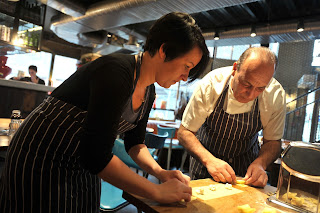A couple of decades ago coffee was the beverage of choice, perhaps in part due to the success of American sitcom Friends, which saw Ross, Rachel and the crew regularly meet at Central Perk – a fictitious coffee shop in New York.
Since then, coffee chains such as Starbucks and Costa have popped up on almost every street corner here in the UK but now, it seems, tea is fighting back.
Top hotels are seeing an increase in afternoon tea bookings – a tradition first made fashionable by the seventh Duchess of Bedford in 1830 – and even old-fashioned tea rooms are seeing a boost in custom.
The Tea Guild’s Irene Gorman said: “Life can be very hectic and taking afternoon tea is an ideal way to slow down and relax.”
I met Mark Nicholls, expert taster for tea producer Twinings, at Woodlands Park Hotel in Cobham to find out more about the beverage, which has more than 1,500 varieties to choose from!
Although tea has long been considered our unofficial national drink, the humble brew is still relatively misunderstood and if you don’t know your jasmine from your Darjeeling, you probably tend to stick to the traditional black variety.
Tea was discovered in China almost 5,000 years ago but it was several thousand years before the plant found its way to other parts of the world.
Today, it is grown on a commercial scale in around three dozen countries including Argentina, India and South Africa, and makes a significant contribution to the economy of the agricultural sector.
There are four distinct types of tea – black, green, oolong and white.
“They all start out from essentially the same bush – camellia sinensis or camellia assamica – but then they undergo a different method of processing,” Mark told me.
He explained that, to make white tea, all moisture is extracted so the leaf becomes dehydrated, while green tea is made by extracting some of the moisture and steaming the leaves so the enzymes are deactivated.
Black and oolong teas have a stronger flavour and are made by fermenting the leaf. While black tea is left to fully oxidise, oolong is only partially oxidised.
If, like me, you go through at least half a dozen mugs of tea a day, you probably don’t put much thought into the making process but there is, in fact, quite an art to creating a decent cuppa.
For example, the water’s temperature can make a real difference. When making white tea, you should use water at around 80 degrees celsius while 98 degrees is better for green tea.
“You shouldn’t actually use boiling water to make certain teas as it can ruin the delicate flavour,” advised Mark.
That’s easy enough if you have a temperature controlled kettle but for those who don’t, you should wait between 30 and 60 seconds to let the water cool down.
The time needed to let tea brew is just as specific. White and green tea should be brewed for about three-and-a-half minutes while black and oolong can be brewed for anything up to nine or 10.
Once our teas were brewed, it was time to do the taste test. Rather like wine tasting, there is a particular method to tea tasting.
Purse your lips as if you are going to give someone a sloppy kiss (Mark’s terminology, not mine!) and rest the spoon of tea on your bottom lip. Then, take a sharp intake of breath to suck all the liquid from the spoon.
“When you slurp the tea to the back of your mouth and then swallow, you are left with a dry sensation and this is you connecting with your olfactory gland,” Mark said.
While I enjoy trying different varieties, I’ve never paid much attention to why I favour certain types over others. Trying the four varieties in immediate succession, I discovered exactly how different they are.
For example, the way white and green teas are processed is similar but the finished products are very different – green has a particularly earthy flavour while white does not. Oolong tea (my favourite) is very strong, as is black tea but this is also very bitter in comparison.
Although I am unlikely to have time to put into practice the lessons I learnt, next time it’s my tea round in the office, I’ll definitely take time out each day to really appreciate a good cup of afternoon tea.
The question is, which of the 1,500 plus teas shall I try next?
This article first appeared in the Surrey Advertiser, May 2011.
























